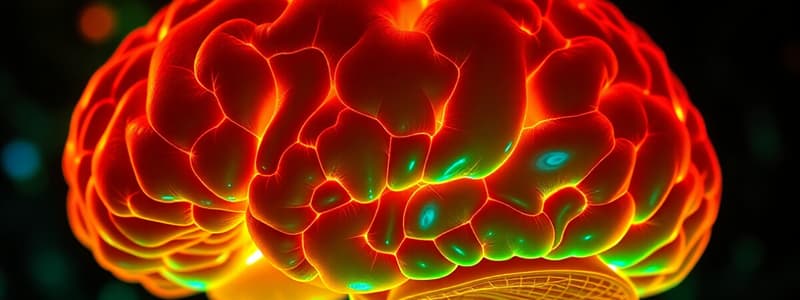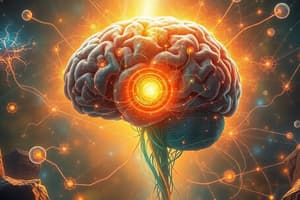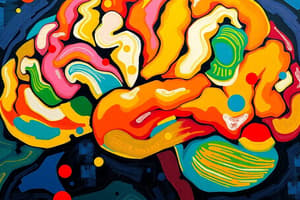Podcast
Questions and Answers
A patient with damage limited to the hippocampus is likely to exhibit what specific memory deficit?
A patient with damage limited to the hippocampus is likely to exhibit what specific memory deficit?
- Deficits in working memory tasks requiring spatial processing.
- Impairment in previously learned motor skills.
- Loss of all pre-existing memories, both declarative and implicit.
- Inability to form new long-term declarative memories. (correct)
Which cellular mechanism is MOST directly involved in strengthening synaptic connections during the early phase of long-term potentiation (LTP)?
Which cellular mechanism is MOST directly involved in strengthening synaptic connections during the early phase of long-term potentiation (LTP)?
- Physical restructuring of the synapse involving dendritic spine growth.
- Retrograde signaling via nitric oxide to enhance presynaptic neurotransmitter release. (correct)
- Activation of Ca-calmodulin-dependent adenylyl cyclase
- Increased synthesis of new AMPA receptors via CREB-mediated transcription.
What is the primary distinction between declarative and non-declarative (implicit) memory systems regarding their dependence on conscious awareness?
What is the primary distinction between declarative and non-declarative (implicit) memory systems regarding their dependence on conscious awareness?
- Both declarative and non-declarative memories require conscious effort during encoding and retrieval.
- Declarative memory requires conscious awareness for both encoding and retrieval, while non-declarative memory does not. (correct)
- Non-declarative memory depends on conscious awareness during encoding but not during retrieval.
- Declarative memory relies on conscious awareness during encoding but not necessarily during retrieval.
In the context of memory consolidation, what is the functional role of protein synthesis in dendritic ribosomes?
In the context of memory consolidation, what is the functional role of protein synthesis in dendritic ribosomes?
How does the application of a drug that selectively blocks cAMP-dependent protein kinase impact long-term memory formation?
How does the application of a drug that selectively blocks cAMP-dependent protein kinase impact long-term memory formation?
Why are recent memories more susceptible to disruption by electroconvulsive shock (ECS) compared to remote memories?
Why are recent memories more susceptible to disruption by electroconvulsive shock (ECS) compared to remote memories?
What role does the cerebellum play in memory, and how does its function differ from that of the hippocampus?
What role does the cerebellum play in memory, and how does its function differ from that of the hippocampus?
How does the function of NMDA receptors contribute to the associative nature of long-term potentiation (LTP) in the hippocampus?
How does the function of NMDA receptors contribute to the associative nature of long-term potentiation (LTP) in the hippocampus?
What is the primary function of the dorsolateral prefrontal cortex (dlPFC) in working memory?
What is the primary function of the dorsolateral prefrontal cortex (dlPFC) in working memory?
In the context of synaptic plasticity, how do kinases contribute to making glutamate receptors more sensitive?
In the context of synaptic plasticity, how do kinases contribute to making glutamate receptors more sensitive?
What distinguishes late-phase LTP from early-phase LTP in terms of molecular mechanisms and duration?
What distinguishes late-phase LTP from early-phase LTP in terms of molecular mechanisms and duration?
A patient who has damage to their amygdala would MOST likely have difficulty with which type of learning?
A patient who has damage to their amygdala would MOST likely have difficulty with which type of learning?
In the context of studying synaptic modifications related to learning, what is a key advantage of using in vitro electrophysiological models like the hippocampal slice preparation?
In the context of studying synaptic modifications related to learning, what is a key advantage of using in vitro electrophysiological models like the hippocampal slice preparation?
How might mutations in the CREB-binding protein (CBP) lead to mental retardation?
How might mutations in the CREB-binding protein (CBP) lead to mental retardation?
Which of the following best describes the impact of temporal lobe lesions (including the hippocampus) on memory?
Which of the following best describes the impact of temporal lobe lesions (including the hippocampus) on memory?
Which of the following scenarios BEST illustrates the dynamics between short-term and long-term memory described in the context of memory consolidation?
Which of the following scenarios BEST illustrates the dynamics between short-term and long-term memory described in the context of memory consolidation?
How does the disruption of cAMP-dependent protein kinase activity selectively impair memory consolidation without directly affecting initial learning?
How does the disruption of cAMP-dependent protein kinase activity selectively impair memory consolidation without directly affecting initial learning?
In a patient exhibiting 'pure' anterograde amnesia following hippocampal damage, what specific cognitive ability would MOST likely remain intact?
In a patient exhibiting 'pure' anterograde amnesia following hippocampal damage, what specific cognitive ability would MOST likely remain intact?
What specific electrophysiological change in hippocampal neurons is both necessary and sufficient for the induction of long-term potentiation (LTP) at Schaffer collateral synapses?
What specific electrophysiological change in hippocampal neurons is both necessary and sufficient for the induction of long-term potentiation (LTP) at Schaffer collateral synapses?
How does the spatial distribution of neurofibrillary tangles in the earliest stages of Alzheimer's disease selectively impair declarative memory?
How does the spatial distribution of neurofibrillary tangles in the earliest stages of Alzheimer's disease selectively impair declarative memory?
Which statement BEST encapsulates the role of dendritic protein synthesis in the late phase of long-term potentiation (LTP)?
Which statement BEST encapsulates the role of dendritic protein synthesis in the late phase of long-term potentiation (LTP)?
How does the localized application of a dopamine-specific neurotoxin in the dorsolateral prefrontal cortex (dlPFC) disrupt working memory performance in a delayed response task?
How does the localized application of a dopamine-specific neurotoxin in the dorsolateral prefrontal cortex (dlPFC) disrupt working memory performance in a delayed response task?
What is the MOST likely mechanism by which mutations in the CREB-binding protein (CBP) lead to intellectual disability?
What is the MOST likely mechanism by which mutations in the CREB-binding protein (CBP) lead to intellectual disability?
How does stimulating the temporal lobe during brain surgery elicit 'vivid experiences of past events', and what does this imply about memory representation?
How does stimulating the temporal lobe during brain surgery elicit 'vivid experiences of past events', and what does this imply about memory representation?
In the context of synaptic plasticity, how does nitric oxide (NO) contribute to long-term potentiation (LTP) following postsynaptic depolarization and calcium influx?
In the context of synaptic plasticity, how does nitric oxide (NO) contribute to long-term potentiation (LTP) following postsynaptic depolarization and calcium influx?
How does the differential sensitivity of recent versus remote memories to disruption by electroconvulsive shock (ECS) provide evidence for memory consolidation?
How does the differential sensitivity of recent versus remote memories to disruption by electroconvulsive shock (ECS) provide evidence for memory consolidation?
A researcher discovers a novel compound that selectively impairs the activity of Ca-calmodulin-dependent protein kinase II (CaMKII) in hippocampal neurons. According to the mechanisms underlying LTP, what specific aspect of synaptic plasticity would MOST likely be affected?
A researcher discovers a novel compound that selectively impairs the activity of Ca-calmodulin-dependent protein kinase II (CaMKII) in hippocampal neurons. According to the mechanisms underlying LTP, what specific aspect of synaptic plasticity would MOST likely be affected?
What is the functional significance of the anatomical separation between working memory and declarative memory systems in the brain?
What is the functional significance of the anatomical separation between working memory and declarative memory systems in the brain?
In the context of cerebellar involvement in motor learning, how would a lesion to the medial dentate and lateral interpositus nuclei MOST likely manifest?
In the context of cerebellar involvement in motor learning, how would a lesion to the medial dentate and lateral interpositus nuclei MOST likely manifest?
How might manipulating the timing of protein synthesis inhibition relative to a learning event differentially affect short-term versus long-term memory formation?
How might manipulating the timing of protein synthesis inhibition relative to a learning event differentially affect short-term versus long-term memory formation?
Flashcards
Reflexive memory
Reflexive memory
Memory with an automatic or reflexive quality, not dependent on awareness or cognitive process; also called implicit memory.
Declarative memory
Declarative memory
Memory that depends on conscious reflection for acquisition and recall, often expressed in declarative statements; also called explicit memory.
Working memory
Working memory
A type of short-term memory used for temporary storage, such as remembering instructions.
Consolidation
Consolidation
Signup and view all the flashcards
Retrograde amnesia
Retrograde amnesia
Signup and view all the flashcards
Anterograde amnesia
Anterograde amnesia
Signup and view all the flashcards
Neurofibrillary tangles
Neurofibrillary tangles
Signup and view all the flashcards
Hippocampal slice
Hippocampal slice
Signup and view all the flashcards
Long-term potentiation (LTP)
Long-term potentiation (LTP)
Signup and view all the flashcards
Magnesium (Mg2+)
Magnesium (Mg2+)
Signup and view all the flashcards
Nitric oxide + citrulline
Nitric oxide + citrulline
Signup and view all the flashcards
CREB-binding protein (CBP)
CREB-binding protein (CBP)
Signup and view all the flashcards
Dorsolateral prefrontal cortex
Dorsolateral prefrontal cortex
Signup and view all the flashcards
Short-term memory
Short-term memory
Signup and view all the flashcards
Long-term memory
Long-term memory
Signup and view all the flashcards
LTP Induction
LTP Induction
Signup and view all the flashcards
Ion Permeability
Ion Permeability
Signup and view all the flashcards
Calcium's Secondary Action
Calcium's Secondary Action
Signup and view all the flashcards
Nuclear Pathway
Nuclear Pathway
Signup and view all the flashcards
Cerebellum
Cerebellum
Signup and view all the flashcards
Long-term potentiation
Long-term potentiation
Signup and view all the flashcards
Study Notes
- There are three major types of memory categories.
- Memories are established in at least two phases.
- Retrograde amnesia and consolidation are key terms to understand in memory processing.
- Long-term and short-term memory can be distinguished.
- Memory is affected by hypothermia, inhibition of protein synthesis, and blocking cyclic AMP pathways.
- Hippocampal lesions have effects on declarative memories; anterograde amnesia is important to the understanding.
- Specific neuroanatomical sites are important for implicit (non-declarative, procedural, reflexive) memories.
- Working memory storage is mediated by various sites in the frontal lobes.
- The temporal lobe shows early degenerative changes (neurofibrillary tangles) in Alzheimer's Disease.
- In vitro electrophysiological model tissues can study cellular mechanisms of learning.
- In the hippocampal slice long-term potentiation model, NMDA receptors function as sources of calcium influx with strong, sustained depolarizing inputs.
- Elevated calcium, working via other second messengers and kinases, mediates synaptic remodeling.
- Roles of mediators are supported by experimental learning models.
- Protein synthesis changes in learning can be sustained by nuclear factors modifying mRNA transcription and proteins produced by dendritic ribosomes.
- Learning mechanisms are a basic property of the nervous system, studied in cellular models and organisms like invertebrates.
- Few clinical instances of memory dysfunction have proven susceptible to a clear understanding of their mechanisms, treatment, or improvement.
- Reading: Kandel, Schwartz, Jessel, Siegelbaum, & Hudspeth; Principles of Neural Science. 5th Ed. (2012. pp. 350-351, 374-381, 1441-1459, & 1461-1520.
Types of Memory
- Reflexive memory has an automatic quality and is not dependent on awareness, consciousness, or cognitive process.
- Reflexive memory is important in learning perceptual and motor skills.
- Reflexive memory can apply to automatic features of speech.
- Reflexive memory is also called implicit memory.
- Declarative memory depends on conscious reflection for acquisition and recall.
- Autobiographical memory is a form of declarative memory.
- Declarative memory consists of memories of events or actions that can be expressed in declarative statements.
- Driving a car initially has a conscious declarative quality but eventually becomes a reflexive memory.
- Declarative memory is also called explicit memory.
- Working memory is short term memory for temporary use.
Phases of Memory
- Types or phases of memory differ in how long they last and how sensitive they are to disruption.
- Long-term memory is permanent, though it may be hard to retrieve, and is not sensitive to disruption by brain hypothermia or electroconvulsive shock.
- Recent memories are more susceptible to disruption by electroconvulsive shock therapy (ECT).
- Graph data supports that after ECT, patients showed memory loss for recent programs (1-2 years old) but not older programs.
- Long-term memory isn't retained in reverberating circuits.
- Manipulations disrupt recently acquired memories, indicating memories transition from a short term, labile state, to a long-term permanent memory state.
- Short-term memory is temporary, lasting a few hours at most.
- Short-term memory may only last minutes when it is working memory, not intended for long-term storage.
- Short-term memory is easily disrupted, and disruption of recent memories by ECS is known as retrograde amnesia.
- Experimental demonstration: Teach animal two tasks a day apart and give ECS right after the 2nd task. Animal retains first task but lacks memory of 2nd task.
- Converting short-term memories to long-term memories is consolidation.
- Inhibition of protein synthesis or cAMP dependent protein kinase do not block learning, but can disrupt consolidation.
- The molecular mechanisms underlying consolidation involve cyclic AMP and protein synthesis mechanisms.
Memory Consolidation
- Different types of memory have different locations.
Declarative Memory
- Temporal lobe and esp. hippocampus are important for declarative memory.
- Temporal lobe lesion (incl. hippocampus): long-term memory remains intact.
- Short-term memory can be acquired, but consolidation does not occur.
- In the case of H.M., hippocampal system removal in the patient resulted in anterograde amnesia.
- Anterograde amnesia is an inability to transfer events to long-term memory.
- The sufferer will be unable to remember anything that occurs after the onset of this type of amnesia for a few moments.
- Sufferers from "pure" anterograde amnesia can still remember memories from before the onset of anterograde amnesia.
- Anterograde amnesia is usually accompanied by retrograde amnesia.
- Skill learning (reflexive memory) is unimpaired, even with hippocampal damage.
- An example is a hippocampal damaged piano player who could learn new tunes (reflexive memory) but have no memory of learning them (declarative memory).
- Temporal lobes are important for memory trace.
- During brain surgery, stimulation of temporal lobes activates "vivid experiences of past events."
- These stimulations activate the "memory neurons" or places that connect to the memory trace.
Long-term Memory
- Various areas are important in localization.
Declarative Memory
- Initially temporal lobe, but also elsewhere as memories become further consolidated.
- Long-term memory traces are found in medio-temporal, frontal & other areas of neocortex.
- Conditioning reflexes to a neutral stimulus (classical conditioning) is abolished by lesion to medial dentate and lateral interpositus nuclei of the cerebellum.
- Conditioning associated changes in electrical activity in these nuclei have been demonstrated.
- Conditioned fear responses are disrupted by lesions in the amygdala.
- Complex tasks involve more than one area of the brain.
- Tasks with a declarative component to them may also be hippocampal-dependent.
- Localization for different types of memories: multiple forms of long term memory are explicit (declarative) and implicit (nondeclarative), as well as working memory.
- Explicit memory includes facts & events using the temporal lobe, medio-temporal, frontal & other areas of neocortex.
- Implicit memory includes priming, procedural learning, associative conditioning, and nonassociative learning using sensory & prefrontal neocortex, striatum, amygdala & cerebellum, and reflex pathways.
- Working memory uses the frontal lobe.
Working Memory
- In monkeys, delayed spatial response is disrupted by bilateral lesions in the prefrontal cortex association area.
- For delayed alternation, a lesion in the principal sulcus disrupts.
- Neurons in this region are activated by spatial cues and continue to fire during the delay period.
- Dopamine is involved in working memory: Delayed alternation is disrupted by electrical stimulation or destruction of dopaminergic endings by localized application of 6-hydroxydopamine.
- Functional magnetic resonance imaging in human has identified an area in the superior frontal sulcus specialized for spatial working memory
- Dorsolateral prefrontal cortex is an area that functions subnormally in many schizophrenics.
- Dendritic spine density in layer three of dorsolateral prefrontal cortex is reduced in schizophrenics.
- Schizophrenic disorganization symptoms include conceptual disorganization, mannerism and posturing, difficulty abstracting, and poor attention.
- fMRI evaluated change in dIPFC activity during a working memory task.
Alzheimer's Disease
- Neurofibrillary tangles, an early degenerative change, starts early and most severely in the hippocampus, entorhinal cortex, and other temporal lobe areas.
Cellular Mechanisms
- Cellular mechanisms are searching for the physical/biochemical change corresponding to a memory.
Synaptic Theory of Learning
- Neuronal changes underlying learning are due to changes in synaptic efficacy.
- Cellular models to study synaptic modifications include Hippocampal slice, Amygdala slice, Cerebellar cortex, Abdominal ganglion of Aplysia.
Hippocampal Slice: A Electrophysiological Model
- Set up for studying LTP in the CA1 region by stimulating the Schaffer collateral pathway electricity and recording the response of the population pyramidal neurons.
- Appearance of the unpotentiated and potentiated CA3-CA1 synaptic potential.
- Comparison of early and late LTP in a cell in the CA1 region.
- The graph is a plot of the slope of the excitatory postsynaptic potentials (EPSPs) in the cell as a function of time.
- The slope is a measure of synaptic efficacy.
- A test stimulus was given every 60 s to the Schaffer collaterals.
- To elicit early LTP a single train of stimuli is given for 1 s at 100 Hz.
- To elicit the late phase of LTP four trains are given separated by 10 min.
- The resulting early LTP lasts 2-3 hours, whereas the late LTP lasts 24 or more hours.
- High frequency stimulation of the Schaffer collaterals causes a long-lasting increase in post-synaptic potentials in pyramidal cells of the CA 1 region of the hippocampus.
- This activation requires simultaneous activation of several collaterals, giving it an associative property.
- Changes here are similar to mechanisms occurring during declarative learning and when the hippocampus becomes epileptic.
- Repeated stimulation of the limbic system causes changes that lower the threshold for subsequent elicitation of seizures.
Cellular Mechanisms
- The Schaffer collaterals use glutamate as transmitter.
- Glutamate acts on both AMPA- and NMDA types of glutamate receptors.
- Ca² through NMDA receptors is necessary for LTP to occur.
- Non-NMDA glutamate receptors are permeable to only Na+ and K+; whereas NMDA receptors are also permeable to Ca2+.
- NMDA Glutamate receptors are gated by Mg2+ at resting potential.
- NMDA receptors must first be depolarized, e.g., by the receptor of AMPA receptors.
- Elevated calcium, working via other second messengers and kinases can mediate synaptic remodeling.
- [Ca2+]; in the post-synaptic cell activates Ca-calmodulin regulated kinase and C kinase to cause LTP to occur.
- These kinases phosphorylate the glutamate receptors, making them more sensitive.
- The kinases also increase insertion of glutamate receptors on reserve in internal vesicles into the synaptic membrane.
- Synaptic ending feed on the presynaptic ending to enhanced transmitter release.
- Nitric oxide (NO) may be involved.
- NO synthesis in neurons is Ca-calmodulin-dependent: arginine---------> NO+ citrulline
- Nitric oxide synthase can be blocked by LNNA or LNMA.
- LNNA or LNMA blocks LTP.
Mechanisms of Late Phase
- Nuclear pathway: Ca-calmodulin activates Ca-calmodulin-dependent adenylyl cyclase, resulting in increased [cAMP], resulting in activation of cAMP-dependent protein kinase.
- This phosphorylates CREB-1, resulting in increased synthesis of specific proteins, resulting in changes in synaptic structure
- Dendritic pathway: Protein synthesis on dendritic ribosomes synthesizes PKMĘ (the “zeta” form of PK resembles PKC but is constitutively active).
- PKMĘ promotes insertion of new glutamate receptors in the synaptic membrane and also feeds back on the dendritic ribosomes or mRNA to sustain the levels of PKM synthesis.
- CREB-deficient mice: maze- and fear learning is disrupted, impairing long-term not short-term learning
- Aplysia: cAMP, calcium, and for long-term memory, CREB-1, nuclear regulation and protein synthesis on synaptic ribosomes all play a role
- Drosophila mutations or modifications of calcium-calmodulin sensitive adenylyl cyclase, CREB, etc. disrupt memory.
- Rubenstein-Taybi syndrome is caused by mutations in the CREB-binding protein (CBP) that assists CREB in activating transcription at cyclic AMP response elements in the nuclear genome.
- Mental retardation is possibly related to CBP role in memory.
Studying That Suits You
Use AI to generate personalized quizzes and flashcards to suit your learning preferences.




